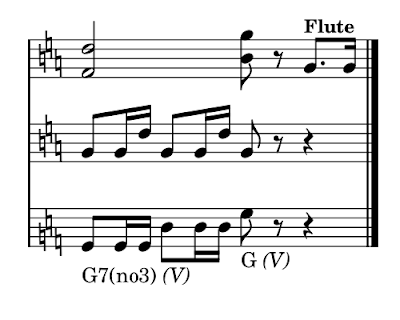 |
| (Click to enlarge) |
Flash Player
Yep, it's "Green Greens". Keep on reading and see what it's got to teach us, as we continue our Kirby Super Star odyssey.
Harmony and Melody
We're back in C, and still in 4/4 time, but we've got our first real key change here; the "B" section switches to the parallel minor, C minor.
We can see the intro is essentially a ii – V – I progression that leads neatly into the first section.
"A" Section
Attentive readers might ask what happened to the triplets in the lead line as I transcribed "Green Greens" in the first article. Turns out I was mistaken, on closer examination it's more accurate to notate the rhythm as the dotted-eighth and sixteenth-note pair used here. Whoops. But even so, what I said in the intro article still applies, the sixteenth notes provide some rhythmic contrast against the "A" section's mostly eighth-note grid. The effect's just not as extreme as full-blown triplets.
The chords used here are all diatonic to C, with one notable exception: check out that E7 in measure 10. Acting as a secondary dominant, it leads us to the following A minor, then the C/G smoothly leads us to the F-G-C run that closes out the section. The C/G (versus a C in root position) was a smart choice, as it allows the bass line to effortlessly glide from A to G to F.
Measures 10-11 also have something to teach us about harmonization; the melody is identical (save for the two Gs at the end) to the melody in the first repeat (m.8-9), yet it sounds dramatically different. Harmony and melody can be thought of as two sides of the same coin, and each can affect the other—even the same melody over different sets of chords can sound totally different.
"B" Section
The "B" section gives us a lot of nice contrast: the accompaniment changes from mainly eighth notes to a prevailing sixteenth-note rhythm, the lead line is now supported by an harmony line, mostly in thirds (though get a load of those sixths it saves for the very end), and most prominently, the key flips to C minor.
The chords here are all diatonic to C minor, but an actual C minor chord never appears. We're treated mostly to the major chords diatonic to C minor (some may notice our old friends ♭VI and ♭VII here; we've been borrowing these from the parallel minor in some of the pieces already covered). The melody on the other hand emphasizes C quite a bit, and the highest climax in the melody in bar 18 has C on top. This keeps us grounded and aware of C as a tonal center.
 |
| "Green Greens" measure 19 extract |
A really brilliant touch is in the very last bar: even though I put the key change back to C major at the beginning of the bar, the defining interval of the G major chord—the third, or B natural in this specific case—does not make an appearance until the very last chord. In fact all the tones in the last bar up until then are identical in both C major or minor, keeping us in the dark about where we're going. What this does is keep us in suspense: are we staying in C minor, or switching back to C major? Or are we going somewhere else entirely? We have to wait until practically the last second before we get any sort of hint.
 |
| "Green Greens" rhythmic motif |
Another bit that's worth mentioning is how much a defining rhythm can add to a piece's memorability and flow. The aforementioned dotted-eighth and sixteenth-note combo is sprinkled liberally throughout the entire melody (go ahead, count how often it appears!), and as different as the sections may be this little recurring unit helps glue everything into a unified whole. Motifs like these can be an essential tool for creating internal logic in a composition.
Arrangement
The arrangement here is quite fluid. The accompaniment at first starts as a sort of synthy piano in the intro, then swiftly changes to Kirby's signature pan flutes, then again switches to a sort of xylophone the second repeat through the "B" section (I didn't notate this in the sheet music for the sake of brevity and legibility). The lead is equally shifting; it starts as a flute, switches to a synth in the "B" section, and the synth's timbre changes again when the xylophone arrives in the accompaniment. Keeping the panflute accompaniment in the first part of the "B" section is a nice touch, as it helps create continuity between the sections. And throughout most of it all the bass assumes an insistent, almost march-like rhythm. All in all it strikes a good balance in keeping things fresh yet flowing.
Last Thoughts
Despite its simple, carefree nature, this piece has excellent examples of many interesting musical techniques such as reharmonization and effectively switching key signatures. I was actually a bit worried beforehand that there might not be anything much to add besides what I wrote in the introduction article, but turns out there was still quite a bit to unearth in "Green Greens". That'll show me! 'Til next time.
_______________

No comments:
Post a Comment